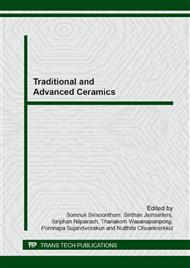p.147
p.153
p.159
p.164
p.170
p.175
p.181
p.187
p.193
Influence of Specimen Dimensions and Temperature on the Debinding Behavior of Alumina Feedstock
Abstract:
This work investigated the influence of specimen dimensions and temperature on the debinding behavior of alumina feedstock for powder injection process. Polyethylene glycol (PEG) was used as a based binder. It is soluble in water therefore the use of wax-based binder system can be avoided. PEGs with a molecular weight of 1500 and 4000 were mixed with polyvinyl butyral (PVB) a minor component. Stearic acid was added during feedstock preparation to act as a lubricant. Debinding process was carried out using a water leaching test at 30 and 70 °C to study for PEG removal rate. Specimens retained their shapes after leaching of the binders. In general, the rate of binder removal increased at initial stage then slowed down at longer leaching times. A faster debinding rate was achieved at 70 °C when compared to 30 °C. In addition, samples with a higher surface area to volume ratio (As/V) led to an increase in the %PEG removal rate. This study also showed the relationship between %PEG removal as a function of different surface area to volume ratio (As/V) which can be helpful in predicting %PEG removal for any other samples having cylindrical shape.
Info:
Periodical:
Pages:
170-174
Citation:
Online since:
April 2014
Keywords:
Price:
Сopyright:
© 2014 Trans Tech Publications Ltd. All Rights Reserved
Share:
Citation:


